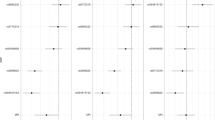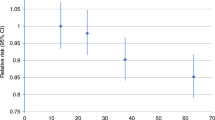Abstract
We investigated effects of occupational physical activity on relative risk for prostate cancer. From Swedish nationwide censuses in 1960 and 1970, we defined two cohorts of men whose occupational titles allowed classification of physical activity levels at work in 1960 (n=1 348 971) and in 1970 (n=1 377 629). A third cohort included only men whose jobs required a similar level of physical activity in both 1960 and 1970 (n=673 443). The incidence of prostate cancer between 1971 and 1989 was ascertained through record linkage to the Swedish Cancer Register. A total of 43 836, 28 702, and 19 670 prostate cancers, respectively, occurred in the three cohorts. In all three cohorts, the relative risk for prostate cancer increased with decreasing level of occupational physical activity (P<0.001), using Poisson regression. Among men with the same physical activity levels in 1960 and 1970, the rate ratio was 1.11 for men with sedentary jobs as compared with those whose jobs had very high/high activity levels after adjustment for age at follow-up, calendar year of follow-up and place of residence (95% CI 1.05–1.17; P for trend <0.001). There was no association between occupational activity and prostate cancer mortality. Since we had no data on other potential risk factors the observed associations for both incidence and mortality might have been confounded. Further studies are needed to better understand the potential role of physical activity for prostate cancer.
This is a preview of subscription content, access via your institution
Access options
Subscribe to this journal
Receive 24 print issues and online access
$259.00 per year
only $10.79 per issue
Buy this article
- Purchase on Springer Link
- Instant access to full article PDF
Prices may be subject to local taxes which are calculated during checkout
Similar content being viewed by others
References
Albanes D, Blair A, Taylor PR (1989) Physical activity and risk of cancer in the NHANES I population. Am J Public Health 79: 744–750
Andersson SO, Baron J, Bergstrom R, Lindgren C, Wolk A, Adami HO (1996) Lifestyle factors and prostate cancer risk: a case-control study in Sweden. Cancer Epidemiol Biomarkers Prev 5: 509–513
Andersson SO, Baron J, Wolk A, Lindgren C, Bergstrom R, Adami HO (1995) Early life risk factors for prostate cancer: a population-based case-control study in Sweden. Cancer Epidemiol Biomarkers Prev 4: 187–192
Andersson SO, Wolk A, Bergstrom R, Adami HO, Engholm G, Englund A, Nyren O (1997) Body size and prostate cancer: a 20-year follow-up study among 135006 Swedish construction workers. J Natl Cancer Inst 89: 385–389
Bairati I, Larouche R, Meyer F, Moore L, Fradet Y (2000) Lifetime occupational physical activity and incidental prostate cancer (Canada). Cancer Causes Control 11: 759–764
Bonnefoy M, Kostka T, Patricot MC, Berthouze SE, Mathian B, Lacour JR (1998) Physical activity and dehydroepiandrosterone sulphate, insulin-like growth factor I and testosterone in healthy active elderly people. Age Ageing 27: 745–751
Brownson RC, Chang JC, Davis JR, Smith CA (1991) Physical activity on the job and cancer in Missouri. Am J Public Health 81: 639–642
Caballero MJ, Mena P, Maynar M (1992) Changes in sex hormone binding globulin, high density lipoprotein cholesterol and plasma lipids in male cyclists during training and competition. Eur J Appl Physiol 64: 9–13
Cerhan JR, Torner JC, Lynch CF, Rubenstein LM, Lemke JH, Cohen MB, Lubaroff DM, Wallace RB (1997) Association of smoking, body mass, and physical activity with risk of prostate cancer in the Iowa 65+ Rural Health Study (United States). Cancer Causes Control 8: 229–238
Chan JM, Stampfer MJ, Giovannucci E, Gann PH, Ma J, Wilkinson P, Hennekens CH, Pollak M (1998a) Plasma insulin-like growth factor-I and prostate cancer risk: a prospective study. Science 279: 563–566
Chan JM, Stampfer MJ, Giovannucci EL (1998b) What causes prostate cancer? A brief summary of the epidemiology. Semin Cancer Biol 8: 263–273
Clarke G, Whittemore AS (2001) Prostate Cancer Risk in Relation to Anthropometry and Physical Activity: The National Health and Nutrition Examination Survey I Epidmeiological Follow-Up Study. Cancer Epidemiology, Biomarkers, Prevention 9: 875–881
Dosemeci M, Hayes RB, Vetter R, Hoover RN, Tucker M, Engin K, Unsal M, Blair A (1993) Occupational physical activity, socioeconomic status, and risks of 15 cancer sites in Turkey. Cancer Causes Control 4: 313–321
Eliakim A, Brasel JA, Mohan S, Wong WLT, Cooper DM (1998) Increased physical activity and the growth hormone-IGF-I axis in adolescent males. Am J Physiol 275: R308–R314
Friedenreich CM, Thune I (2001) A review of physical activity and prostate cancer risk. Cancer Causes Control 12: 461–475
Gann PH, Hennekens CH, Ma J, Longcope C, Stampfer MJ (1996) Prospective study of sex hormone levels and risk of prostate cancer. J Natl Cancer Inst 88: 1118–1126
Giovannucci E, Leitzmann M, Spiegelman D, Rimm EB, Colditz GA, Stampfer MJ, Willett WC (1998) A prospective study of physical activity and prostate cancer in male health professionals. Cancer Res 58: 5117–5122
Hartman TJ, Albanes D, Rautalahti M, Tangrea JA, Virtamo J, Stolzenberg R, Taylor PR (1998) Physical activity and prostate cancer in the Alpha-Tocopherol, Beta-Carotene (ATBC) Cancer Prevention Study (Finland). Cancer Causes Control 9: 11–18
Hsing AW, McLaughlin JK, Zheng W, Gao YT, Blot WJ (1994) Occupation, physical activity, and risk of prostate cancer in Shanghai, People's Republic of China. Cancer Causes Control 5: 136–140
Ilic M, Vlajinac H, Marinkovic J (1996) Case-control study of risk factors for prostate cancer. Br J Cancer 74: 1682–1686
Lund Nilsen TI, Johnsen R, Vatten LJ (2000) Socio-economic and lifestyle factors associated with the risk of prostate cancer. Br J Cancer 7: 1358–1363
McTiernan A, Ulrich C, Slate S, Potter J (1998) Physical activity and cancer etiology: associations and mechanisms. Cancer Causes Control 9: 487–509
Medlund P, Cederlöf R, Floderus-Myrhed B, Friberg L, Sörensen S (1977) A new Swedish twin registry. Acta Med Scand Suppl 600 1–111
Moradi T, Nyren O, Bergstrom R, Gridley G, Linet M, Wolk A, Dosemeci M, Adami HO (1998) Risk for endometrial cancer in relation to occupational physical activity: a nationwide cohort study in Sweden. Int J Cancer 76: 665–670
Nindl BC, Kraemer WJ, Deaver DR, Peters JL, Marx JO, Heckman JT, Loomis GA (2001) LH secretion and testosterone concentrations are blunted after resistance exercise in men. J Appl Physiol 91: 1251–1258
Öberg S, Springfeldt P (1991) The national atlas of Sweden Stockholm: Statistics Sweden
Official Statistics of Sweden (1971) Census of the Population and Housing in 1970, 1.4. pp. 1–258, Stockholm: Statistics Sweden
Official Statistics of Sweden (1975) Census of the Population and Housing in 1970; part 13: Occupation and education pp. 1–206, Stockholm: Statistics Sweden
Official Statistics of Sweden (1995) Reports on statistical co-ordination (1982) Swedish socio-economic classification. pp. 11–19, Stockholm: Statistics Sweden
Oliveria SA, Kohl III HW, Trichopoulos D, Blair SN (1996) The association between cardiorespiratory fitness and prostate cancer. Med Sci Sports Exerc 28: 97–104
Preston DL, Lubin JH, Pierce DA (1995) EPICURE: Generalized Regression Models for Epidemiologic Data Seattle, WA: HiroSoft International Corporation
Putnam SD, Cerhan JR, Parker AS, Bianchi GD, Wallace RB, Cantor KP, Lynch CF (2000) Lifestyle and anthropometric risk factors for prostate cancer in a cohort of Iowa men. Ann Epidemiol 10: 361–369
Ross R, Schottenfeld D (1996) Prostate cancer. InCancer epidemiology and prevention. Schottenfeld D, Fraumeni Jr J (eds) pp1180–1206, New York, Oxford: Oxford University Press
Rothman K, Greenland S (1998) Modern epidemiology. pp. 127–130, Philadelphia: Lippincott-Raven
Severson RK, Nomura AM, Grove JS, Stemmermann GN (1989) A prospective analysis of physical activity and cancer. Am J Epidemiol 130: 522–529
Shephard RJ, Shek PN (1995) Cancer, immune function, and physical activity. Can J Appl Physiol 20: 1–25
Stattin P, Bylund A, Rinaldi S, Biessy C, Dechaud H, Stenman UH, Egevad L, Riboli E, Hallmans G, Kaaks R (2000) Plasma insulin-like growth factor-I, insulin-like growth factor-binding proteins, and prostate cancer risk: a prospective study. J Natl Cancer Inst 92: 1910–1917
Steenland K, Nowlin S, Palu S (1995) Cancer incidence in the National Health and Nutrition Survey I. Follow- up data: diabetes, cholesterol, pulse and physical activity. Cancer Epidemiol Biomarkers Prev 4: 807–811
The Swedish Cancer Registry (2001) Cancer Incidence in Sweden 1999. Vol. 4 pp. 18–23, Stockholm: The National board of Health and Welfare
Thune I, Lund E (1994) Physical activity and the risk of prostate and testicular cancer: a cohort study of 53,000 Norwegian men. Cancer Causes Control 5: 549–556
Tikkanen HO, Hamalainen E, Sarna S, Adlercreutz H, Harkonen M (1998) Associations between skeletal muscle properties, physical fitness, physical activity and coronary heart disease risk factors in men. Atherosclerosis 137: 377–389
Tissandier O, Peres G, Fiet J, Piette F (2001) (r=−0.47, P= 0.05). These results suggest that regular physical activity could maintain higher DHEAS and IGF-1 and lean body mass levels in elderly men, and participate in general well being in older age. Eur J Appl Physiol 85: 177–184
Tymchuk CN, Barnard RJ, Heber D, Aronson WJ (2001) Evidence of an inhibitory effect of diet and exercise on prostate cancer cell growth. J Urol 166: 1185–1189
Tymchuk CN, Tessler SB, Aronson WJ, Barnard RJ (1998) Effects of diet and exercise on insulin, sex hormone-binding globulin, and prostate-specific antigen. Nutr Cancer 31: 127–131
Vena JE, Graham S, Zielezny M, Brasure J, Swanson MK (1987) Occupational exercise and risk of cancer. Am J Clin Nutr 45: 318–327
Villeneuve PJ, Johnson KC, Kreiger N, Mao Y (1999) Risk factors for prostate cancer: results from the Canadian National Enhanced Cancer Surveillance System. The Canadian Cancer Registries Epidemiology Research Group. Cancer Causes Control 10: 355–367
Wolk A, Andersson SO, Bergstrom R (1997) Prospective study of sex hormone levels and risk of prostate cancer. [letter; comment]J Natl Cancer Inst 89: 820
Wolk A, Mantzoros CS, Andersson SO, Bergstrom R, Signorello LB, Lagiou P, Adami HO, Trichopoulos D (1998) Insulin-like growth factor 1 and prostate cancer risk: a population-based, case-control study. J Natl Cancer Inst 90: 911–915
Zmuda JM, Thompson PD, Winters SJ (1996) Exercise increases serum testosterone and sex hormone-binding globulin levels in older men. Metabolism 45: 935–939
Acknowledgements
This work was supported by National Institutes of Health, National Cancer Institute, Bethesda, MD, USA; and the Swedish Cancer Society.
Author information
Authors and Affiliations
Corresponding author
Appendix 1
Appendix 1
Rights and permissions
About this article
Cite this article
Norman, A., Moradi, T., Gridley, G. et al. Occupational physical activity and risk for prostate cancer in a nationwide cohort study in Sweden. Br J Cancer 86, 70–75 (2002). https://doi.org/10.1038/sj.bjc.6600023
Received:
Revised:
Accepted:
Published:
Issue Date:
DOI: https://doi.org/10.1038/sj.bjc.6600023
Keywords
This article is cited by
-
Physical Activity and Prostate Cancer: An Updated Review
Sports Medicine (2017)
-
Physical activity and body mass index as predictors of prostate cancer risk
World Journal of Urology (2015)
-
Potential for prostate cancer prevention through physical activity
World Journal of Urology (2012)
-
Epidemiologische Evidenz zur Prävention des Prostatakarzinoms durch körperliche Aktivität
Wiener Medizinische Wochenschrift (2012)
-
Exercise therapy across the prostate cancer continuum
Prostate Cancer and Prostatic Diseases (2009)



